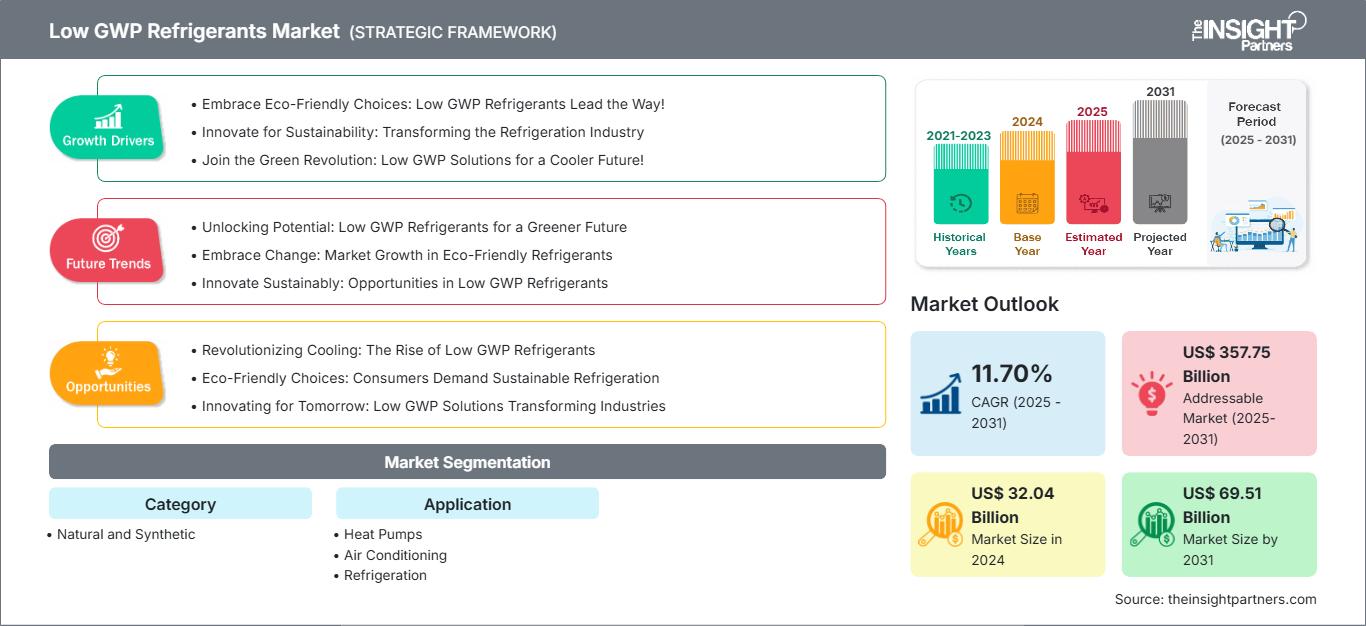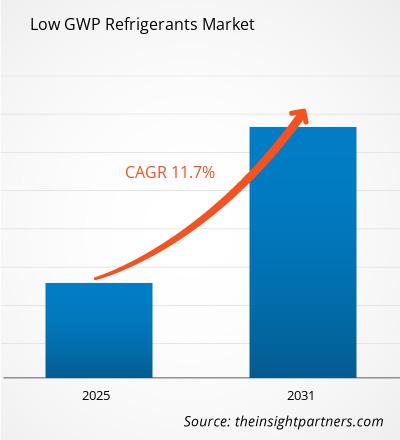Si prevede che il mercato dei refrigeranti a basso GWP registrerà un CAGR dell'11,70% dal 2025 al 2031, con una dimensione del mercato in espansione da 32,04 miliardi di dollari nel 2024 a 69,51 miliardi di dollari entro il 2031.
Il rapporto è suddiviso per categoria (naturali e sintetici) e analizza ulteriormente il mercato in base all'applicazione (pompe di calore, condizionamento dell'aria, refrigerazione). Per ciascuno di questi segmenti chiave viene fornita una ripartizione completa a livello globale, regionale e nazionale.
Il rapporto include dimensioni e previsioni di mercato per tutti i segmenti, con valori espressi in USD. Fornisce inoltre statistiche chiave sullo stato attuale del mercato dei principali attori, oltre ad approfondimenti sulle tendenze di mercato prevalenti e sulle opportunità emergenti.
Scopo del rapporto
Il rapporto "Low GWP Refrigerants Market" di The Insight Partners mira a descrivere il panorama attuale e la crescita futura, i principali fattori trainanti, le sfide e le opportunità. Questo fornirà spunti di riflessione a diversi stakeholder aziendali, tra cui:
- Fornitori/produttori di tecnologia: per comprendere le dinamiche di mercato in evoluzione e conoscere le potenziali opportunità di crescita, consentendo loro di prendere decisioni strategiche informate.
- Investitori: per condurre un'analisi completa delle tendenze in merito al tasso di crescita del mercato, alle proiezioni finanziarie del mercato e alle opportunità esistenti lungo la catena del valore.
- Enti di regolamentazione: regolamentano le politiche e le attività di controllo sul mercato con l'obiettivo di ridurre al minimo gli abusi, preservare la fiducia degli investitori e sostenere l'integrità e la stabilità del mercato.
Segmentazione del mercato dei refrigeranti a basso GWP
Categoria
- Naturale e sintetico
Applicazione
- Pompe di calore
- Aria condizionata
- Refrigerazione
Riceverai la personalizzazione gratuita di qualsiasi report, incluse parti di questo report, analisi a livello nazionale, pacchetto dati Excel e potrai usufruire di fantastiche offerte e sconti per start-up e università.
Mercato dei refrigeranti a basso GWP: approfondimenti strategici

-
Scopri le principali tendenze di mercato di questo rapporto.Questo campione GRATUITO includerà analisi dei dati, che spaziano dalle tendenze di mercato alle stime e alle previsioni.
Fattori di crescita del mercato dei refrigeranti a basso GWP
- Scegli scelte ecosostenibili: i refrigeranti a basso GWP sono all'avanguardia!
- Innovare per la sostenibilità: trasformare il settore della refrigerazione
- Unisciti alla Rivoluzione Verde: soluzioni a basso GWP per un futuro più fresco!
Tendenze future del mercato dei refrigeranti a basso GWP
- Sbloccare il potenziale: refrigeranti a basso GWP per un futuro più verde
- Abbracciare il cambiamento: crescita del mercato dei refrigeranti ecocompatibili
- Innovare in modo sostenibile: opportunità nei refrigeranti a basso GWP
Opportunità di mercato per i refrigeranti a basso GWP
- Rivoluzionare il raffreddamento: l'ascesa dei refrigeranti a basso GWP
- Scelte ecologiche: i consumatori chiedono una refrigerazione sostenibile
- Innovazione per il futuro: soluzioni a basso GWP che trasformano le industrie
Approfondimenti regionali sul mercato dei refrigeranti a basso GWP
Le tendenze regionali e i fattori che influenzano il mercato dei refrigeranti a basso GWP durante il periodo di previsione sono stati ampiamente spiegati dagli analisti di The Insight Partners. Questa sezione analizza anche i segmenti e la geografia del mercato dei refrigeranti a basso GWP in Nord America, Europa, Asia-Pacifico, Medio Oriente e Africa, America Meridionale e Centrale.
Ambito del rapporto di mercato sui refrigeranti a basso GWP
| Attributo del report | Dettagli |
|---|---|
| Dimensioni del mercato nel 2024 | 32,04 miliardi di dollari USA |
| Dimensioni del mercato entro il 2031 | 69,51 miliardi di dollari USA |
| CAGR globale (2025 - 2031) | 11,70% |
| Dati storici | 2021-2023 |
| Periodo di previsione | 2025-2031 |
| Segmenti coperti |
Per categoria
|
| Regioni e paesi coperti |
America del Nord
|
| Leader di mercato e profili aziendali chiave |
|
Densità degli operatori del mercato dei refrigeranti a basso GWP: comprendere il suo impatto sulle dinamiche aziendali
Il mercato dei refrigeranti a basso GWP è in rapida crescita, trainato dalla crescente domanda degli utenti finali, dovuta a fattori quali l'evoluzione delle preferenze dei consumatori, i progressi tecnologici e una maggiore consapevolezza dei vantaggi del prodotto. Con l'aumento della domanda, le aziende stanno ampliando la propria offerta, innovando per soddisfare le esigenze dei consumatori e sfruttando le tendenze emergenti, alimentando ulteriormente la crescita del mercato.

- Ottieni una panoramica dei principali attori del mercato dei refrigeranti a basso GWP
Punti di forza chiave
- Copertura completa: il rapporto copre in modo esaustivo l'analisi di prodotti, servizi, tipologie e utenti finali del mercato dei refrigeranti a basso GWP, fornendo un panorama olistico.
- Analisi degli esperti: il rapporto è redatto sulla base della conoscenza approfondita di esperti e analisti del settore.
- Informazioni aggiornate: il rapporto garantisce la pertinenza aziendale grazie alla copertura delle informazioni più recenti e delle tendenze dei dati.
- Opzioni di personalizzazione: questo report può essere personalizzato per soddisfare le esigenze specifiche del cliente e adattarsi in modo appropriato alle strategie aziendali.
Il rapporto di ricerca sul mercato dei refrigeranti a basso GWP può quindi contribuire a tracciare un percorso di decodificazione e comprensione dello scenario e delle prospettive di crescita del settore. Sebbene possano esserci alcune valide preoccupazioni, i vantaggi complessivi di questo rapporto tendono a superare gli svantaggi.
- Analisi storica (2 anni), anno base, previsione (7 anni) con CAGR
- Analisi PEST e SWOT
- Valore/volume delle dimensioni del mercato - Globale, Regionale, Nazionale
- Industria e panorama competitivo
- Set di dati Excel
Report recenti
Testimonianze
Motivo dell'acquisto
- Processo decisionale informato
- Comprensione delle dinamiche di mercato
- Analisi competitiva
- Analisi dei clienti
- Previsioni di mercato
- Mitigazione del rischio
- Pianificazione strategica
- Giustificazione degli investimenti
- Identificazione dei mercati emergenti
- Miglioramento delle strategie di marketing
- Aumento dell'efficienza operativa
- Allineamento alle tendenze normative






















 Ottieni un campione gratuito per - Mercato dei refrigeranti a basso GWP
Ottieni un campione gratuito per - Mercato dei refrigeranti a basso GWP